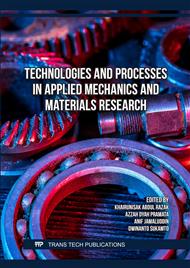[1]
Silva M S, Barbosa C, Acselrad O and Pereira L C 2004 Effect of chemical composition variation on microstructure and mechanical properties of a 6060 aluminum alloy J. Mater. Eng. Perform. 13 129–34
DOI: 10.1361/10599490418307
Google Scholar
[2]
Jamaly N, Haghdadi N and Phillion A B 2015 Microstructure, Macrosegregation, and Thermal Analysis of Direct Chill Cast AA5182 Aluminum Alloy J. Mater. Eng. Perform. 24 2067–73
DOI: 10.1007/s11665-015-1480-7
Google Scholar
[3]
Xu R F, Zheng H L, Luo J, Ding S P, Zhang S P and Tian X L 2014 Role of tensile forces in hot tearing formation of cast Al-Si alloy Trans. Nonferrous Met. Soc. China 24 2203–7
DOI: 10.1016/s1003-6326(14)63333-1
Google Scholar
[4]
CHEN D xu, DOU R feng, HAN J qiang and WANG J sheng 2020 Prediction of hot tearing susceptibility of direct chill casting of AA6111 alloys via finite element simulations Trans. Nonferrous Met. Soc. China (English Ed. 30 3161–72
DOI: 10.1016/s1003-6326(20)65451-6
Google Scholar
[5]
Zheng X, Luo P, Dong J and Ding W 2017 Effect of direct chill casting process parameters on the microstructure and macrosegregation of Mg-Al-Zn ingot Mater. Trans. 58 1197–202
DOI: 10.2320/matertrans.m2017013
Google Scholar
[6]
Suyitno 2005 Hot tearing and deformation in direct-chill casting of aluminum alloys
Google Scholar
[7]
Grandfield, J.F.; Eskin, D.G,; Bainbridge I F 2013 Direct-Chill Casting of Light Alloys (United States of America: John Wiley & Sons, Inc., Hoboken, New Jersey)
DOI: 10.1002/9781118690734
Google Scholar
[8]
Lebon G.S.B, Li H.T, Patel J.B, Assadi H. and Fan Z 2020 Numerical modelling of melt-conditioned direct-chill casting Appl. Math. Model. 77 1310–30
DOI: 10.1016/j.apm.2019.08.032
Google Scholar
[9]
Suyitno, Kool W H and Katgerman L 2005 Hot tearing criteria evaluation for direct-chill casting of an Al-4.5 pct Cu alloy Metall. Mater. Trans. A Phys. Metall. Mater. Sci. 36 1537–46
DOI: 10.1007/s11661-005-0245-6
Google Scholar
[10]
Eskin D.G, Zuidema J, Savran V.I. and Katgerman L 2004 Structure formation and macrosegregation under different process conditions during DC casting Mater. Sci. Eng. A 384 232-44
DOI: 10.1016/j.msea.2004.05.066
Google Scholar
[11]
Lalpoor M, Eskin D G, Ruvalcaba D, Fjær H G, Ten Cate A, Ontijt N and Katgerman L 2011 Cold cracking in DC-cast high strength aluminum alloy ingots: An intrinsic problem intensified by casting process parameters Mater. Sci. Eng. A 528 2831–42
DOI: 10.1016/j.msea.2010.12.040
Google Scholar
[12]
Eskin D G, Savran V I and Katgerman L 2005 Effects of melt temperature and casting speed on the structure and defect formation during direct-chill casting of an Al-Cu alloy Metall. Mater. Trans. A Phys. Metall. Mater. Sci. 36 1965–76
DOI: 10.1007/s11661-005-0059-6
Google Scholar
[13]
Wang R, Zuo Y, Zhu Q, Liu X and Wang J 2022 Effect of temperature field on the porosity and mechanical properties of 2024 aluminum alloy prepared by direct chill casting with melt shearing J. Mater. Process. Technol. 307 117687
DOI: 10.1016/j.jmatprotec.2022.117687
Google Scholar
[14]
Eskin D G 2008 Physical metallurgy of direct chill casting of aluminum alloys
DOI: 10.1201/9781420062823
Google Scholar
[15]
Jolly M and Katgerman L 2021 Modelling of defects in aluminium cast products Prog. Mater. Sci. 100824
Google Scholar
[16]
Eskin D G, Savran V I and Katgerman L 2005 Effects of melt temperature and casting speed on the structure and defect formation during direct-chill casting of an Al-Cu alloy Metall. Mater. Trans. A 36 1965–76
DOI: 10.1007/s11661-005-0059-6
Google Scholar
[17]
Suyitno A, Eskin D G, Savran V I and Katgerman L 2004 Effects of alloy composition and casting speed on structure formation and hot tearing during direct-chill casting of Al-Cu alloys Metall. Mater. Trans. A Phys. Metall. Mater. Sci. 35 A 3551–61
DOI: 10.1007/s11661-004-0192-7
Google Scholar
[18]
Carlberg T and Jarfors A E W 2014 On vertical drag defects formation during direct chill (DC) casting of aluminum billets Metall. Mater. Trans. B Process Metall. Mater. Process. Sci. 45 175-81
DOI: 10.1007/s11663-013-0009-4
Google Scholar
[19]
Fegade R S, Tated R G and Nehete R S 2019 Critical review on pull-in of aluminium in continuous casting Int. J. Sci. Technol. Res. 8 1948–57
Google Scholar
[20]
Håkonsen A, Hafsås J E and Ledal R 2014 A New DC Casting Technology for Extrusion Billets with Improved Surface Quality Light Met. 2014 9781118889 873–8
DOI: 10.1007/978-3-319-48144-9_146
Google Scholar



